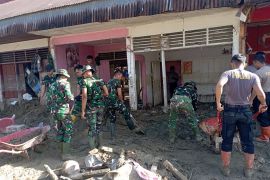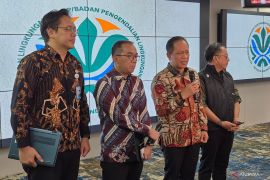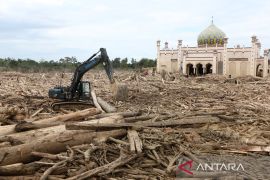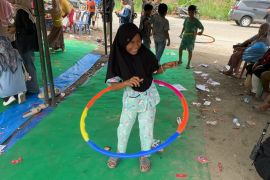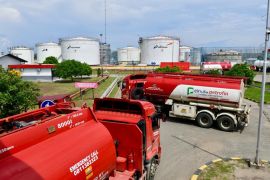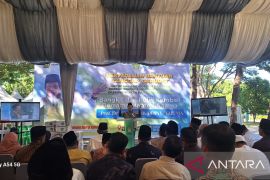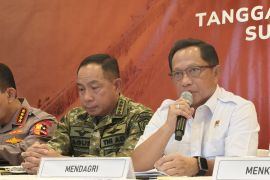During 2014, some 1,525 disaster events occurred in the archipelagic country, killing 566 people, displacing 2.66 million others, and damaging over 51,000 homes and hundreds of public facilities, according to spokesman of the National Disaster Mitigation Agency (BNPB) Sutopo Purwo Nugroho earlier this year.
Ninety-nine percent of the natural disasters hitting Indonesia in 2014 were hydro-meteorological in nature -- floods, landslides, and whirlwinds.
The Agency released data showing that 496 instances of whirlwinds, 458 floods, and 413 landslides affected Indonesia last year.
Landslides led to 338 deaths, displaced 79,341 residents, and damaged 5,814 houses in Indonesia last year, according to Nugroho.
This year, until April 25, 46 people were killed in landslides, the BNPB spokesman noted in a press statement on April 27, 2015.
The Agency revealed that 40.9 million or around 17.2 percent of Indonesian citizens are living in 274 districts or cities throughout the country which are prone to landslides.
The 40.9 million residents include 4.28 million toddlers, 323 thousand disabled people, and 3.2 million elderly, who are hardly able to protect themselves when disaster happen.
They are exposed to landslides that could claim their lives, and therefore, disaster mitigation efforts must be intensified in those regions, he affirmed.
Sumatra, Sulawesi and Java Islands, including West, Central and East Java provinces, are most prone to landslide disasters.
Wonogiri, Bogor, Wonosobo, Bandung, Garut, Banyumas, Semarang, Sukabumi, Cilacap, Cianjur, Temanggung, Ponorogo, Kebumen, and Purbalingga are some of the districts mapped by the agency as being prone to landslides.
Chairman of the BNPB Syamsul Maarif has prioritized the completion of a master plan on landslide disaster risk reduction in 2015.
The master plan not only lays emphasis on the installation of early warning system (EWS) devices but also on capacity building, early warning chain system, empowerment of the community, and the familiarization of disaster mitigation efforts.
An EWS device was recently installed by the Yogyakarta-based University of Gajah Mada (UGM) in Karanganyar.
However, out of hundreds of thousands of EWS devices needed throughout the country, the government has managed to install only around 100 units so far, he pointed out.
The UGM has installed 20 units of EWS, notably 10 units in Central Java and another 10 in West Java.
In December 2014, landslides hit Banjarnegara, Central Java, killing 99 people, and rendering 11 others missing.
The Banjarnegara district administration in Central Java had extended the emergency status until January 18, 2015.
"Based on the decision of the Banjarnegara district head, the emergency status has been extended to another two weeks, from January 5 to 18, 2015," spokesman of the local Disaster Mitigation Office (BPBD), Catur Subandrio, said in early January 2015.
As rainy season is predicted to last until May 2015, some areas in Indonesia still face floods and landslides.
In Rabi Jonggor village, Gunung Tuleh Sub-district, West Pasaman District, West Sumatra Province, a landslide cut off some roads, isolating thousands of local villagers on April 24, 2015.
Adjunct Commissioner Muzhendra of the West Pesaman Police Office said recently that incessant heavy rains that had fallen since April 23, triggered the landslide which did not claim any lives.
On April 25, a landslide struck Lembah Hijau area, Wosi village, Manokwari District, West Papua, forcing tens of local residents to evacuate to safer places.
"Residents of Lembah Hijau took refuge following a landslide that buried a house owned by Orpa Koday on Saturday (April 25) evening," Yustin Wakum, a local inhabitant, stated on April 27, 2015.
In early April, Sukabumi authorities in West Java Province declared a landslide emergency status as the district is frequently hit by landslides.
"The landslide emergency status has been declared since January. Several command posts have been set up to anticipate more disasters," Head of the Sukabumi disaster mitigation office Adjo Sardjono stated on April 3, 2015.
Cimerak was among villages hit by landslides in which 12
inhabitants were killed in March 2015. In Cibadak sub-district, landslides hit 18 areas and damaged a number of houses.
Sukabumi is ranked third in the list of Indonesias districts most prone to landslides.
At least 40 out of the 47 sub-districts in the district are prone to landslides in the current rainy season.
Besides landslides, Sukabumi is also prone to earthquake, floods, and whirlwind.
In March 2015, floods and landslides affected some villages in Pituruh sub-district, Purworejo District, Central Java, killing a villager and demaging three houses.
Villages that have been affected by the natural disasters were Pamriyan, Wonosido, Sawangan and Purbayan, Head of the Purworejo Disaster Mitigation Office Budi Harjono said last month.
In Bengkulu Province, Sumatra Island, 20 locations in Bengkulu were hit by landslides that killed four villagers in February 2015, according to the Bengkulu Disaster Mitigation Office (BPBD).
The nine landslide-affected districts were North Bengkulu, Mukomuko, Seluma, Central Bengkulu, Kepahiang, Rejanglebong, Lebong, South Bengkulu, and Kaur.
In January 2015, a landslide affected Garung Lor village in Sukoharjo sub-district, Wonosob District, Central Java Province, forcing hundreds of villagers to evacuate themselves to a safer places.
In the meantime, Social Affairs Minister Khofifah Indar Parawansa earlier this year said some 274 districts and cities in Indonesia have been identified as areas prone to floods and landslides..
The social affairs ministry has allocated Rp235 billion for disaster-hit victims in the State Budget for 2015 and Rp70 billion more in the Amended State Budget.
Vice President Jusuf Kalla, former chief of the Indonesian Red Cross (PMI), said education and awareness about natural disasters can minimize their impact, including human casualty rates, in vulnerable areas.
"We should decrease the impact of natural disasters by remaining well prepared and well aware," Kalla stated while speaking at the National Coordination Meeting of the National Disaster Mitigation Agency (BNPB) in March 2015.
According to Kalla, people who live in areas prone to natural disasters must understand the potential calamities that can occur in their regions and comprehend how to act during emergencies. (*)
(T.F001/A/F001/A014) 29-04-2015 21:08:47
Reporter: Fardah
Editor: Fardah Assegaf
Copyright © ANTARA 2015
